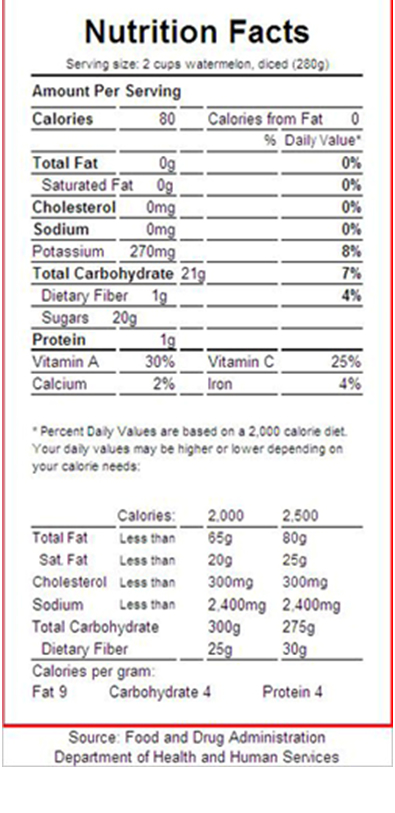NUTRITION
Lycopene Leader
Watermelon is the Lycopene Leader in fresh produce, having higher concentrations of lycopene than any other fresh fruit or vegetable. In fact, fresh watermelon contains higher levels of lycopene than fresh tomatoes - a 2-cup serving of watermelon contains and average of 18.16 mg and one medium-sized tomato contains 4 mg.
Heart Healthy
Watermelon has heart healthy properties because it is naturally low in saturated fat, total fat and cholesterol.
A recent study by the United States Department of Agriculture (USDA) about watermelon consumption and heart healthy benefits was completed and published March 2007. The NWPB has four new structure-function claims derived from this study:
- Watermelon consumption increases free arginine and citrulline, which can help maintain cardiovascular function.
- Eating watermelon can help maintain cardiovascular health.
- Watermelon has amino acids such as citrulline and arginine that help maintain the arteries.
- Watermelon amino acids citrulline and arginine can help maintain blood flow and heart health.
5-A-Day turns to Fruit and Veggies!
The Produce for Better Health Foundation, American Cancer Institute, ACIR Report indicates people who eat five or more servings of fruit and vegetables every day have half the risk of developing cancer as those who only eat one or two servings per day. That's a very good reason to eat your fruit and vegetables! Look for recipes that per serving contain at least one serving of fruits and vegetables with no more than 30% of the calories from fat, 10% from saturated fat, 100 milligrams cholesterol and 480 milligrams sodium
vegetables every day have half the risk of developing cancer as those who only eat one or two servings per day. That's a very good reason to eat your fruit and vegetables! Look for recipes that per serving contain at least one serving of fruits and vegetables with no more than 30% of the calories from fat, 10% from saturated fat, 100 milligrams cholesterol and 480 milligrams sodium
- Watermelon Is Practically A Multivitamin Unto Itself
A 2-cup serving of watermelon is an excellent source of Vitamins A, B6 and C. - Vitamin A found in watermelon is important for optimal eye health.
- Vitamin B6 found in watermelon is used by the body to manufacture brain chemicals (neurotransmitters), such as serotonin, melatonin and dopamine, which preliminary research shows may help the body cope with anxiety and panic.
- Vitamin C in watermelons can help to bolster your immune system's defenses against infections and viruses and is known to stimulate the immune system and protect against free radical damage.
- Potassium
A two-cup serving of watermelon is also a source of potassium*, a mineral necessary for water balance and found inside of every cell. People with low potassium levels can experience muscle cramps. A two-cup serving has less than 10 percent of the daily reference value for potassium.
FUN FACTS
Fun Facts
- The first recorded watermelon harvest occurred nearly 5,000 years ago in Egypt.
- Over 1,200 varieties of watermelons are grown worldwide in 96 countries.
- In some Mediterranean countries, the taste of watermelon is paired with the salty taste of feta cheese.
- Watermelon is 92% water.
- Watermelon's official name is Citrullus Lanatus of the botanical family Curcurbitaceae. It is cousins to cucumbers, pumpkins and squash.
- By weight, watermelon is the most-consumed melon in the U.S., followed by cantaloupe and honeydew.
- Early explorers used watermelons as canteens.
- The first cookbook published in the U.S. in 1796 contained a recipe for watermelon rind pickles.
- In 1990, Bill Carson of Arrington, TN grew the largest watermelon at 262 pounds that is still on the record books (1998 ed. Guinness Book of World Records).
- Watermelon has no fat or cholesterol and is an excellent source of vitamins A, B6 and C and contains fiber and potassium.
Email us at info@watermelon.org for more fun facts!
Types and Varieties of Watermelon
About 200-300 varieties are grown n the U.S. and Mexico, although there are about 50 varieties that are very popular. You can do an online search or contact a seed company to find out more about common and historic watermelon varieties. The modern watermelon lover sees his or her watermelon options as the 5 types below.
Seeded Watermelon
Oblong in shape
Weight can range from 15-45 lbs. on average
Small to large brown or black seeds throughout
Seedless Watermelon - The most popular in the U.S.
Round shape
Weight can range from 10-20 lbs. on average
No seeds, although the occasional seed may occur
Mini or Personal-Sized Watermelon
Small and round in shape
1-7 lbs. in weight
Red or yellow flesh
Seeded or seedless
Yellow Flesh and Orange Flesh Watermelons
Round in shape
Weight averages 10-30 lbs.
Usually has seeds
Commonly used in food service environments
How a watermelon is grown
Producers generally grow watermelon in rows, 8-12 feet apart, in raised beds 4-12 inches high composed of fertilized sand or sandy loam.
Tiny watermelon plants from a transplant nursery are implanted in the beds. Honeybees must pollinate the yellow watermelon blossom. Even the sterile, seedless watermelon requires pollination in order to fruit. In a month, a vine may spread to as much as 6-8 feet. Within 60 days, the vine produces its first watermelons and the crop is ready to harvest within 90 days.
The rind of a watermelon is deceptively hardy looking, but is actually quite fragile, requiring handpicking. Watermelon producers look for a pale or buttery yellow spot on the bottom, indicating ripeness.
History of Watermelon
Watermelon is thought to have originated in the Kalahari Desert of Africa. The first recorded watermelon harvest occurred nearly 5,000 years ago in Egypt and is depicted in Egyptian hieroglyphics on walls of their ancient buildings. Watermelons were often placed in the burial tombs of kings to nourish them in the afterlife.
From there, watermelons spread throughout countries along the Mediterranean Sea by way of merchant ships. By the 10th century, watermelon found its way to China, which is now the world's number one producer of watermelons.
The 13th century found watermelon spread through the rest of Europe via the Moors.
Southern food historian, John Egerton, believes watermelon made its way to the United States with African slaves as he states in his book, "Southern Food."
The United States currently ranks fourth in worldwide production of watermelon. Forty-four states grow watermelons with Florida, Texas, California, Georgia and Arizona consistently leading the country in production.
HOW DO WE GET SEEDLESS WATERMELONS?
The Watermelon Itself
Seedless watermelons were invented over 50 years ago, and they have few or no seeds. When we say seeds, we are talking about mature seeds, the black ones. Oftentimes, the white seed coats where a seed did not mature are assumed to be seeds. But this isn’t the case! They are perfectly safe to swallow while eating, and don’t worry - no seeds will grow in your stomach.
So, how are seedless watermelons grown? Chromosomes are the building blocks that give characteristics, or traits, to living things including plants and watermelons. Watermelon breeders discovered that crossing a diploid plant (bearing the standard two sets of chromosomes) with a tetraploid plant (having four sets of chromosomes) results in a fruit that produces a triploid seed. (Yes, it has three sets of chromosomes). This triploid seed is the seed that produces seedless watermelons!
In other words, a seedless watermelon is a sterile hybrid which is created by crossing male pollen for a watermelon, containing 22 chromosomes per cell, with a female watermelon flower with 44 chromosomes per cell. When this seeded fruit matures, the small, white seed coats inside contain 33 chromosomes, rendering it sterile and incapable of producing seeds. This is similar to the mule, produced by crossing a horse with a donkey. This process does not involve genetic modification.
How They're Planted
The seedless watermelons need seeded watermelons in order to be pollinated and set fruit. In a watermelon field where they're growing seedless, roughly 25% of the plants are seeded varieties and 75% are seedless varieties. Hives of bees are brought into the fields to cross-pollinate from the seeded plants to the seedless plants. Without this cross-pollination, the seedless watermelon plants would not produce fruit.
Seedless watermelon varieties are more difficult to grow than their seedier cousins but it can be done. Your best bet is to germinate these pricier seeds indoors at an optimal 85º F, and plant them outdoors after soil temperatures have warmed to at least 70º F. It's easier to buy melon transplants and set them out when temperatures are in the 80s. Because seedless melons are sterile and produce little pollen, you'll need to also plant a normal pollinator variety of watermelon in the patch so the bees can pollinate the flowers, contributing to the development of flavorful, well-formed fruit.
SELECTION, STORAGE & HANDLING
How to choose a watermelon
It's as easy as 1, 2, 3.
- Look the watermelon over.
You are looking for a firm, symmetrical watermelon that is free from bruises, cuts or dents. - Lift it up.
The watermelon should be heavy for its size. Watermelon is 92% water, most of the weight is water. - Turn it over.
The underside of the watermelon should have a creamy yellow spot from where it sat on the ground and ripened in the sun.
De-seeding a watermelon:
If you would like to de-seed a watermelon, here's a nice and easy way to do it. This is perfect to dice up into chunks for a snack, use in salsa, mix into drinks or anything else you would use watermelon for.
Be sure to wash your watermelon
and knives before cutting into it.
- Cut watermelon in half, then in quarters
- Cut through the flesh of the melon along the seed line with a pairing knife. Now, lift off the piece you just cut out.
- Using a fork, scrape the seeds from the piece you just removed and from the remaining flesh on the rind.
Storage and Handling of watermelon
- Handle your whole watermelon gently, to avoid internal bruising.
- Wash hands.
- Wash your watermelon in running water, rinse well and pat dry.
- Cut the flesh from the rind, and cut into 1-inch cubes.
- Place in covered container and refrigerate immediately.
- Keep cut watermelon refrigerated until consumed, up to 3-4 days.
Choosing and Handling Pre-Cut Watermelon
- The flesh of the watermelon should appear dense and firm.
- Refrigerate to preserve maximum freshness.
- Cover the cut surface of a melon with plastic wrap to prevent the flesh from becoming mushy.
- Store chunks of watermelon in covered plastic containers.
Quick Tips for Watermelon Cubes and Wedges
Cutting up a watermelon is faster and easier than you may think! All you have to do is cut it in a grid pattern, almost like you were making a checkerboard on the surface of the fruit. Cubes will tumble out ready to eat.
Quick Watermelon Cubes
- Take a quarter watermelon and lay it on the rind with the interior facing up.
- Place knife about 3/4 of an inch down from the peak of the wedge. Holding the knife parallel to the far side of the fruit and starting at edge of rind, cut a horizontal line through the fruit all the way down to the rind.
- Next, place the knife blade 3/4 of an inch lower and make the same cut. Repeat.
- Next, turn the fruit to the other side and make the same horizontal cuts.
- And last, starting at edge of the rind, make vertical cuts 3/4 inch apart all the way across.
- Cubes will tumble out ready to eat!
Quick Watermelon Wedges
- Take a quarter watermelon and lay it on the rind with the interior facing up. Place knife about two inches from end of wedge.
- Cut off the curved end of the fruit. Place knife about ¾ to 1 inch (or desired thickness) into fruit and cut straight down.
- Repeat until entire quarter is in wedges.

